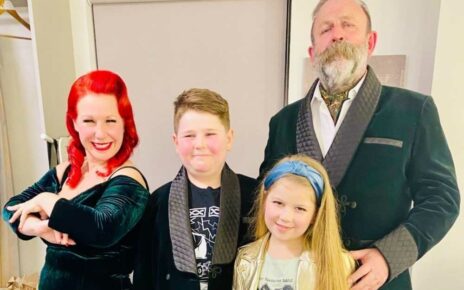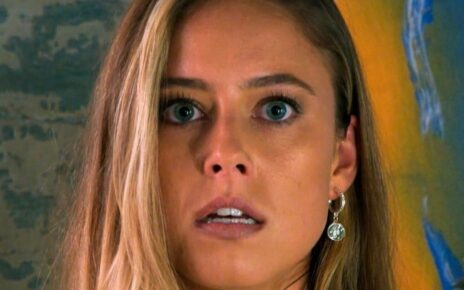When it comes to recreating the distant past onscreen, all we can really do is guess at how things looked based on what evidence is left behind. Our imagination of medieval and medievalist settings are in large part based on the wind-blasted shells of castles and the arch stonework of cathedrals, which means that, whether you’re in King’s Landing or King Henry’s court, all too often the medieval world is nasty, brutal, and short on color. It’s gray and black and occasionally scorched by firelight, as if nobody worked in primary colors until Da Vinci.
But looking at the time period this way is a little bit like extrapolating what an animal looks like based just on its bones — you miss the things that actually give it shape and character and life. Among the many virtues of “Catherine Called Birdy” is that Lena Dunham’s adaptation of the beloved Karen Cushman novel builds a world as spirited and colorful as the film’s protagonist.
Production designer Kave Quinn did not need to look too far afield in order to build a version of the fictional town of Stonebridge (in the shire of Lincoln, in the kingdom of England, in the hands of God — and shot on location at Stokesay Castle in Shropshire), turning to illustrated manuscripts from the late 13th century for examples of the period’s color and beauty. “One of the things that Lena really wanted to bring into the film was this vibrancy,” Quinn told IndieWire. “It makes you connect more with the people, not seeing them in a drab kind of environment… you can get a real feeling of how life was.”
Our connection with Birdy (Bella Ramsey) starts immediately, as she’s hauled into her room for a second bath (!) inside the manor house ruled over by her profligate, merry father, Lord Rollo (Andrew Scott), and her wise, forbearing mother, Lady Aislinn (Billie Piper). The house looks truly lived in, nearly every inch of it painted in rich reds and blues. It’s adorned with carved flourishes and ornate objects, be they wooden birds or the magnificent red woven bedspread, to give the space a sense of the human hand — and Birdy’s hand specifically. “It was like an embodiment of her imagination,” Quinn said.


“Catherine, Called Birdy”
Alex Bailey/Prime Video
The house also becomes a dimension of her imagination, as it features strongly in her desire to first delay the time when a match might be made for her, and later to put off any would-be suitors. (Both phases of Birdy’s plans involve the manor’s outhouse, for one.) Even in the plain spaces where the daughter of a lord ought not go — but perhaps finds herself occasionally eavesdropping on conversations from the other side of a doorway — Quinn took care to scatter straw across the plain floorboards so that the house never feels staid or monumental. It’s constantly shaped by the people living in it, whether that shaping involves hanging garlands for Christmas pageants or stripping down tapestries to pay off the house’s debts.
Quinn and her team traveled to India to look for a lot of the props that give the manor house its personality, both to adhere to Rollo’s worldly, expensive taste and because of the level of craftsmanship available in the country’s furniture, soft goods, and objets d’art. Much of what they purchased there underwent a sort of ad hoc aging process as it sat, stuck in a container ship, during the production’s COVID-19 pause. The team took advantage of this unanticipated bump in the road, imbuing the sets and props with a sense of the everyday wear-and-tear that might occur in a house where a teenager has free rein.


“Catherine, Called Birdy”
TIFF
A small village was constructed on the Stokesay grounds for “Catherine Called Birdy,” which Quinn described as an accurate reflection of the proximity between knight’s castles and the medieval towns that built up around them. But some verisimilitude had to be sacrificed for the very modern needs of filmmaking. “Originally, [the manor] would’ve had stained glass windows, but they’d gone, so we had to put our own in,” Quinn said. “There’d be terrible gales running through the building, so it was a challenge for the DP, and we actually had to build some medieval scaffolding outside, which he used to light when we were filming the interiors.
“[That became] part of the story of the castle, and it being in disrepair — it had some half-constructed scaffolding outside of it. So we integrated that design element into the castle so that [DP Laurie Rose] could light the great hall.”
The great hall has its fair share of bare stonework, but not for lack of trying to adorn it. In addition to the stained glass, wall hangings and a faux medieval tile floor were brought in. The high table for Lord Rollo, his family, and guests is forever strewn with flowers and colorful cloth, and piled high with fruits and trenchers of meat in addition to the de rigueur roast pig. The overall result is a subtle tension between the imposing walls of the manor and the warmth inside of it, one that reflects the central tension of the film, between Birdy’s desire for fun, freedom, and adventure and society’s expectations for her. Birdy mirrors and feels part of this place she loves, which makes us love it too.
“When you do a project like this, you have to do the research, really get down to what things were like, and then make your own take on it,” Quinn said. “So I found that really exciting because Lena really wanted to push the boat out. And I think that the color came to life beautifully in ‘Birdy’ and helped enhance the story. I just hope for lots of young girls who watch it, they can really see something of their lives in this film — but also really connect to people from those days. It hasn’t really changed that much.”
Source: Read Full Article


